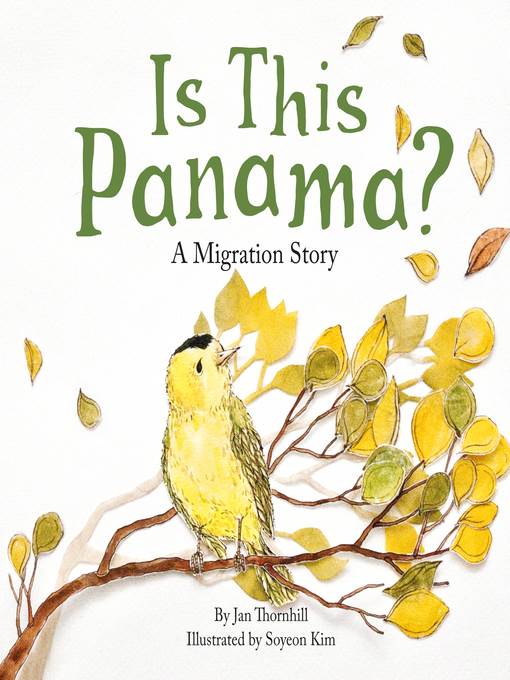
Is This Panama?
A Migration Story
فرمت کتاب
ebook
تاریخ انتشار
2014
Lexile Score
620
Reading Level
2-3
نویسنده
Soyeon Kimناشر
Owlkids Books Inc.شابک
9781771470377
کتاب های مرتبط
- اطلاعات
- نقد و بررسی
- دیدگاه کاربران
نقد و بررسی

August 12, 2013
As the air near the Arctic Circle turns chilly, Sammy learns that his fellow Wilson’s warbler birds have already flown south, and he must follow. But how to find the way? During his out-of-the-way route, he meets other animals on the move, including sandhill cranes, a snake (“I follow the scent of other snakes to an underground cave where hundreds of us sleep away the winter together”), and humpback whales. Sammy finally learns that warblers typically migrate at night, using the stars as a map. Kim’s three-dimensional collages are well suited to the theme of flight: birds, butterflies, and dragonflies appear to lift off the pages. Appended materials include warbler migration routes and details about migratory species. Ages 5–8.

November 1, 2013
K-Gr 2-Sammy is a young Wilson's warbler, a bird that lives near the Arctic Circle. He knows that when it gets cold, it is time to fly south to Panama. However, he has somehow missed the other warblers' departure. Making the journey on his own, Sammy learns about several animals that migrate, including caribou, garter snakes, monarch butterflies, and humpback whales. Sammy's confusion allows for a broader discussion of migration as the animals tell him how they use scents, food availability, landmarks, the stars, and other signs from nature to tell them where to go. The logic breaks down, however, because Sammy does not know what to do. The back matter says, "Songbirds don't need to be shown the way because they have their migration routes hardwired into their brains at birth." If that is true, why is Sammy an exception? A map shows the warblers' regular route versus Sammy's circuitous one. No scientific sources are listed in the book, although the explanations provided match up with other sources consulted. Delicate, three-dimensional illustrations combine natural materials, sketching, and painting. Pieces appear to be constructed, then cut out and arranged to create the complete image. The pages are beautifully composed to capture the scale of the animals with Sammy providing perspective. Teachers and other adults should be prepared to offer nonfiction migration books to expand on the scientific elements presented in the story.-Lucinda Snyder Whitehurst, St. Christopher's School, Richmond, VA
Copyright 2013 School Library Journal, LLC Used with permission.

August 1, 2013
Sammy the young Wilson's warbler's freezing toes tell him it's time to migrate, but how will he find his way from his home in the Arctic Circle to Panama when all the other birds have already left? After several fruitless attempts to solve this problem by questioning other birds and animals, he sets off, hitching a ride on a sandhill crane and following the shoreline with a flock of darner dragonflies. Other warblers show him how to navigate by the stars, but the confusion of city lights leads to a painful encounter with a skyscraper window. Challenged by the uber-migrant Hudsonian godwit, Sammy sets out over the ocean, island hopping all the way to Mexico. The instincts of the tiny bird are true, and they lead him to his final destination. Thornhill's authoritative yet friendly and accessible text, coupled with Kim's decorative pen-and-wash collaged illustrations, make this an appealing book for children who appreciate realism and authentic detail in a picture book. The endpapers depict realistic sketches of a few of the vast variety of warblers, and a map of bird migration routes completes this charming and unusual nature storybook. A brief introduction to the other animals and birds mentioned in the story is also included. Possibilities for use in the classroom are endless. An unusual and attractive take on a perennially absorbing topic. (Picture book. 6-10)
COPYRIGHT(2013) Kirkus Reviews, ALL RIGHTS RESERVED.

September 15, 2013
Grades 1-3 A young bird finds he is all alone and goes on a quest to find his kind. No, this isn't P. D. Eastman's Are You My Mother? (1960) but, rather, an ecologically sophisticated variation. The bird is a Wilson's warbler that must make his first migration south; the refrain of this journey is, of course, Is this Panama? This is an unusually appealing book about nature's cycles, not just because of its near-guaranteed happy ending but because of the lively, informative text, as young Sammy meets a succession of other creatures, from a caribou to the monarch butterflies to humpback whales, most of whom do make some sort of migration (and their paths are described at the end of the book). Kim's illustrations, a mix of line drawings, painting, and cut paper, are full of movement, color, and texture, offering up wonderfully varied landscapes and scenes that suggest three dimensions. Together, the text and images help make sense of a few of nature's curiosities. A truly educational journey.(Reprinted with permission of Booklist, copyright 2013, American Library Association.)

























دیدگاه کاربران